Energy free residences are not only practical but they are the dwellings of the future. Let's hope that home builders start thinking zero net energy as they design upcoming housing subdivisions.
Len Calderone for | AltEnergyMag
An energy free home is also known as a zero net energy house, which means the home is completely energy self-sufficient. This can be achieved with solar or wind power, but the ultimate goal is to spend nothing on your energy use after the initial cost of installation.
Traditional buildings consume 40% of the total fossil fuel energy in the U.S. and are substantial suppliers of greenhouse gases. An energy free home is one that reduces carbon emissions and dependence on fossil fuels. Presently, these types of homes are scarce.
Today’s basic home is designed pretty much the same as they always have been no matter where it is located, except in some areas, such as Anchorage, where heat is most important, while in other areas, such as Phoenix, air conditioning is essential. Yet in both of these areas, heating and cooling use the same basic source of energy.
When talking energy free, every solution is local and is dependent on the area. What works in sunny Los Angeles will not work in windy Chicago. To accomplish an energy free home, performance goals must be established that actually make sense in a certain climate zone. It’s one thing to say that a passive solar design is great, but is it practical where the home is located.
 |
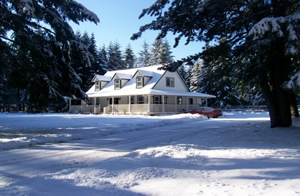 |
| Home in the desert | Home in the north |
To start with, it makes sense to reduce the home’s energy budget before selecting any renewable energy system. To accomplish this, a full analysis needs to be made of how the energy will be used and what appliances will be employed, such as Energy Star rated appliances. The occupants will need to know just how much energy each appliance uses and control this usage
Next select an energy management system to monitor usage and to shut off appliances when not in use. To make the water heater more efficient, the best temperature for showers and dish washing must be established. Almost every item in the house offers opportunities for reduction, from faucets to lighting fixtures.
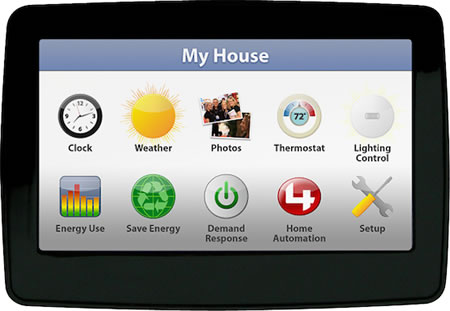
EMS EC-100 energy management system
The best way to be aware of your home’s surroundings and energy consumption is by using technology. Energy management systems can monitor and control your home’s energy consumption though data provided by the smart meter. The system will also tell you how much energy is used by your A/V system, security, lights, and HVAC.
Every part of the home’s construction should be optimized, including the walls, plumbing, ductwork and windows. It will be hard to save energy if the home’s construction is not properly insulated.
Start with an energy efficient foundation by using insulated concrete forms to save up to 30% of the house’s energy. Use only the best insulation, and seal all openings where air flow wastes energy. Windows and doors can make a big difference if energy savings is important. Look for Energy Star rated windows with Low-E glass.
Where possible, use large overhangs to keep the summer sun from the windows. Window coverings and shades provide added insulation.
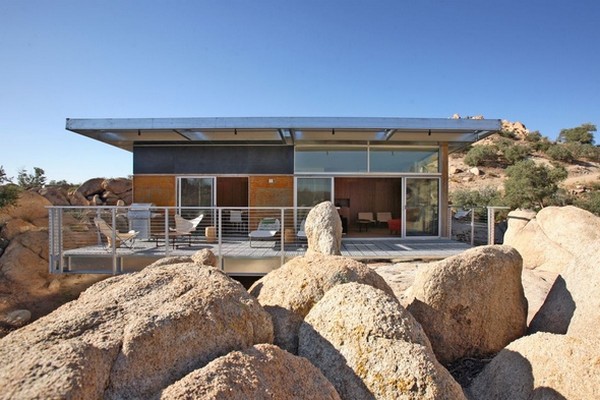
Keep sunlit rooms well ventilated to prevent overheating, by using ceiling fans. Use only properly sized furnaces, which do not cycle on and off, wasting energy. Because most of the heated air will escape through the ceiling or attic, insulate this area well or use structural insulated panels for the roof.

A structural insulated panel (SIP) is a product that fuses a foam core, like expanded polystyrene, between two outer skins of Oriented Strand Board (OSB) to create a super-strong construction panel. They are used to construct exterior walls, roofs, ceilings and floors. Homes and buildings constructed from SIPs offer superior insulation qualities, exceptional strength, fast installation and a host of benefits to the environment.
An on-demand tankless water heater keeps energy costs down by eliminating the need to keep 40 gallons of water heated day and night, and they take up considerably less room than the water heaters that we have used for decades, where the heat is constantly lost through the walls of the tank.
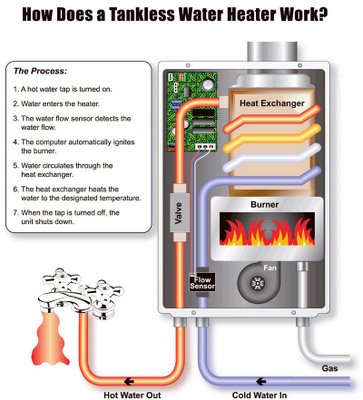
If there is a fireplace, use glass doors and a heater/blower to optimize the heat generated by the fire. Most of us are now using CFL lamps instead of the old incandescent bulbs, as they give the same amount of visible light, but use a fraction of the energy, while lasting 8 -15 times longer.
An energy free house is one that uses no more energy over the course of the year than is produced from on-site renewable sources, such as solar and wind power.
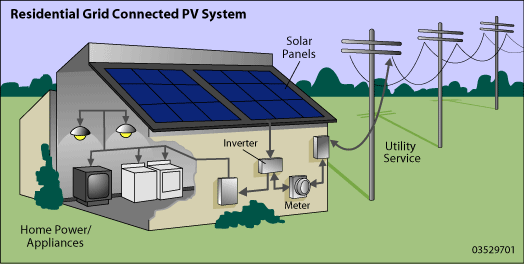
At the end of the day, buying solar is a great option because as soon as the initial investment has been recovered, homeowners have little to no electricity bills and receive their renewable, clean power on-site, virtually for free. The important consideration here is that the solar panels are able to supply enough energy to run the house with maybe a little left over to sell back to the power company.
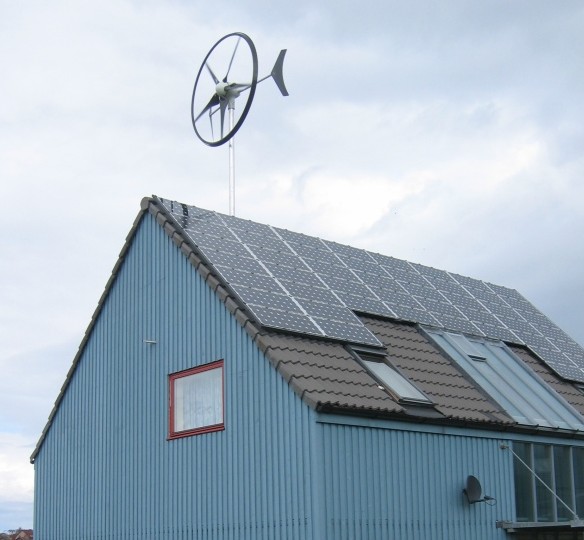
Wind power systems use turbines of suitable sizes that spin a generator, converting the wind’s energy into usable electricity. A wind power system, whether grid tied or standalone, could be practical if you don’t expect to offset all of your energy usage with solar, and you reside in a location with steady winds and fairly open lands. The windiness of a place can be measured objectively with an anemometer. The wind generator would be used to supplement a home’s solar array, as opposed to being the sole source of renewable energy.
While the upfront cost might be somewhat high to have an energy free home, you don’t have to be a building science geek to see that home energy efficiency can have a big environmental impact, as for every unit of usable electricity that is not used, three units of primary energy is actually saved.
We're getting only 32% efficiency out of our electricity generation here in the US. Those three kWh of primary energy that is saved for each kWh reduction means less pollution from the power plant, less digging to get coal out of the ground, and less transportation energy to ship coal across the country.
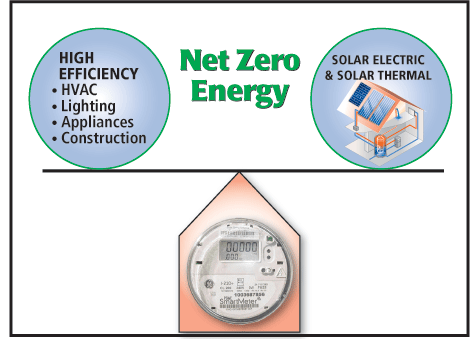
To obtain an energy free home, solar panels will need to be installed on the roof with a high-efficiency electric heat pump, passive solar architecture, and extremely efficient fixtures and appliances. This system will allow the home to “sell back” excess energy it generates during sunny days and to purchase energy like any other home during nights and cloudy days, unless a windmill is used to supplement the solar panels. Over the course of a year, the power bills should achieve a net zero energy equilibrium.
An energy expert can look at a home from roof to basement and identify where energy efficiency improvements can be made, and inform the home owner where energy costs can be saved, where the home’s performance can be improved, and what improvements can be made for a healthier living environment.
Energy free residences are not only practical but they are the dwellings of the future. Let’s hope that home builders start thinking zero net energy as they design upcoming housing subdivisions.
For additional information:
1. http://www.biomassthermal.org/programs/documents/118_ZEBCriticalLookDefinition.pdf
2. http://www.nrel.gov/docs/fy00osti/27835.pdf
3. http://www.energystar.gov/ia/business/challenge/learn_more/ResidentialNewConstruction.pdf
4. http://www.dmme.virginia.gov/DE/LinkDocuments/HandbookNewConstruction.pdf
About Len
Len has contributed articles to several publications. He also writes opinion editorials for a local newspaper. He is now retired.
This article contains statements of personal opinion and comments made in good faith in the interest of the public. You should confirm all statements with the manufacturer to verify the correctness of the statements.
The content & opinions in this article are the author’s and do not necessarily represent the views of AltEnergyMag
Comments (0)
This post does not have any comments. Be the first to leave a comment below.


